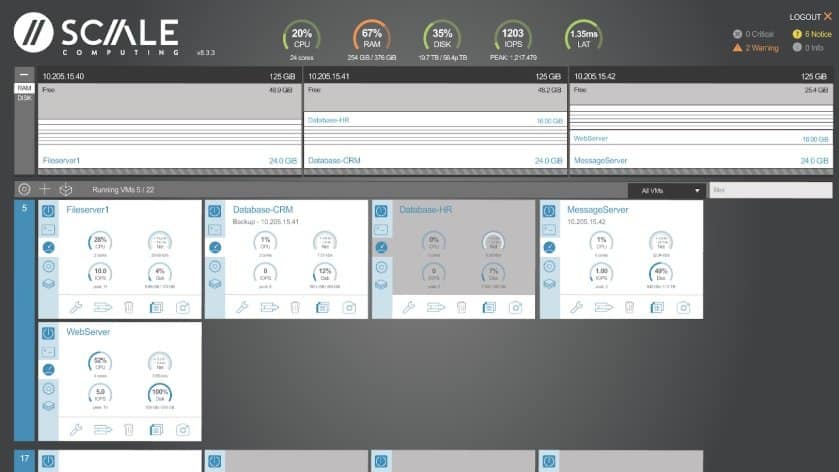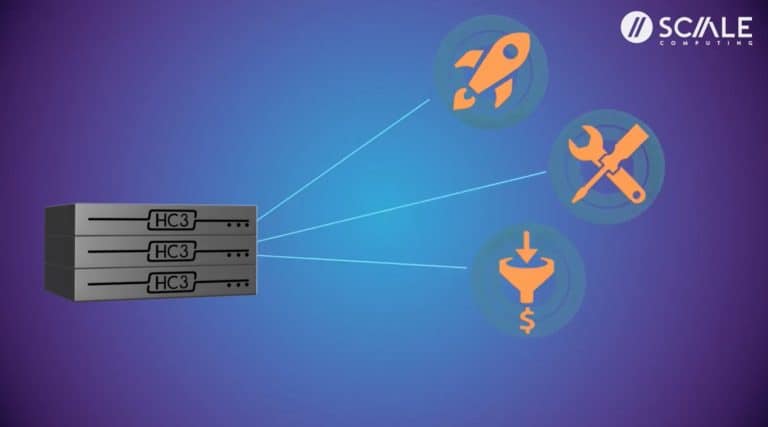Companies don’t seem to get enough of expanding their IT infrastructure. Over the past few years an increased demand for cloud services has led to larger infrastructure. Research expects companies will once again spend more money on these IT assets this year, which makes infrastructure one of the few growth areas due to the corona crisis. However, this growing infrastructure also increases the complexity. Scale Computing wants to remove this complexity with with its Hyper-Converged Infrastructure (HCI) product. Recently we spoke Johan Pellicaan, Vice President EMEA at Scale Computing.
Scale Computing has been taking advantage of the market in recent years. It may not be the best-known infrastructure vendor, but like the other big HCI companies, it knows how to achieve growth. According to Scale Computing the growth is accelerated by the simplicity of the product, while the strategic partnerships are also very important. It resulted in Scale Computing becoming an HCI vendor with more than 5,000 customers globally. At Techzine, we are convinced that IT vendors will only achieve and maintain such a position with a strong vision, resulting in the development of good products.
How does the HCI approach work?
Scale Computing has chosen three key pillars for its appliances and platform, called HC3. These include servers, storage, and a hypervisor to manage virtualisation. This is in line with Gartner’s HCI definition, which says it consists of a standard server in combination with software to unify storage, compute and server virtualisation. In addition, software-defined networking is on the radar of Scale Computing.
Scale Computing has chosen KVM as hypervisor. By opting for this open-source virtualisation layer, Scale Computing can run many virtual machines (VMs) on its appliances, each VM having their own tasks and responsibilities. This whole virtualisation idea, splitting up the capacity of the nodes, should ensure that every application can run on the HC3 platform. Scale Computing adds additional necessary elements to KVM for this purpose. Within HC3 it is possible to run applications on the Linux or Windows operating system. In addition, existing VMs from VMware or Hyper-V, for example, are easily migrated to Scale Computing’s KVM-based virtualisation environment. Ultimately, the use of an open-source hypervisor should minimise restrictions; for example, it’s possible to migrate virtual machines without affecting the connected clients and workload in the VM. According to Scale Computing, opting for the open-source hypervisor should give them an advantage over competitors, where users sometimes have to pay for the use of a hypervisor HCI provider developed.
Scale Computing has also added a storage layer to the hypervisor. This SCRIBE architecture creates a storage pool and is responsible for managing data within nodes and clusters. By integrating SCRIBE directly, this should result in significant performance advantages, partly because Scale Computing has built its own technologies around it. Together they ensure that block storage is handled intelligently enabling virtual machines within HC3 to perform as well as possible and ensuring they have high availability. To achieve this, Scale Computing continuously monitors the environment.
In every situation, servers will be used for these functionalities. Think about devices like a microserver to run a few VMs at the edge or 2U appliances running hundreds of VMs and multiple CPUs.

Partnerships contribute to the current market position
There is a Scale Computing cloud application, which is developed in collaboration with Google Cloud Platform. HC3 Cloud Unity allows the HCI solution to run in the cloud, which is primarily intended to replicate data between the Google Cloud and on-premise Scale Computing systems. HC3 Cloud Unity is basically an additional option to protect data with full disaster recovery functionalities.
These partnerships are incredibly important and form the basis of Scale Computing’s current market position. In addition to the intensive Google Cloud partnership, Lenovo is also an essential partner for Scale Computing, both as an investor and technology partner. Thanks to this partnership, Scale Computing delivers its HC3 software on Lenovo servers. This makes Scale Computing one of Lenovo’s largest virtualisation partners, which is good for the company’s footprint. For example, the 800 Delhaize supermarkets in Belgium use the Lenovo and Scale Computing platform because of their partnership.
In addition, collaborations are often necessary to expand functionality. For example, HC3, just like any other HCI solution, offers out-of-the-box functionality for data protection, but it should be connected to a data management solution to maximise the protection. In this respect, Scale Computing has developed extensive integrations with Acronis to protect infrastructure against ransomware attacks.
Virtualisation at the edge and further steps
As mentioned earlier, Scale Computing is also looking at its role in networking, and it seems that an interesting development is imminent regarding edge computing. With edge computing, data is processed at the source, which means that latency in the network is not or hardly allowed. What can HCI do for this specific application?
Scale Computing found the answer in the upcoming HC3 Edge Fabric. Scale Computing uses this network architecture to connect the nodes to each other, so not every HC3 appliance needs to be connected directly to a switch. This is good for the placement of the nodes and reduces cabling, which is desirable for the success of edge computing. In shops and restaurants, for example, such factors can be quite decisive.
This innovation also highlights Scale Computing’s commitment to advancing edge computing. The company introduced multiple edge computing appliances because many customers run critical applications at the edge of their network. Pellicaan truly believes that many sectors will benefit from this technology: from supermarkets to casinos and from shipping to small offices.
Scale Computing believes that its approach can be valuable to all kinds of organisations, regardless the size and sector of such an organisation. Simplicity ought to be the keyword at all times, enabling virtualisation for non-infrastructure managers as well. This approach has led to a bigger market share for Scale Computing in recent years. The company wants to keep going in this direction. We are eager to see how the HCI vendor will develop further in the near future.
